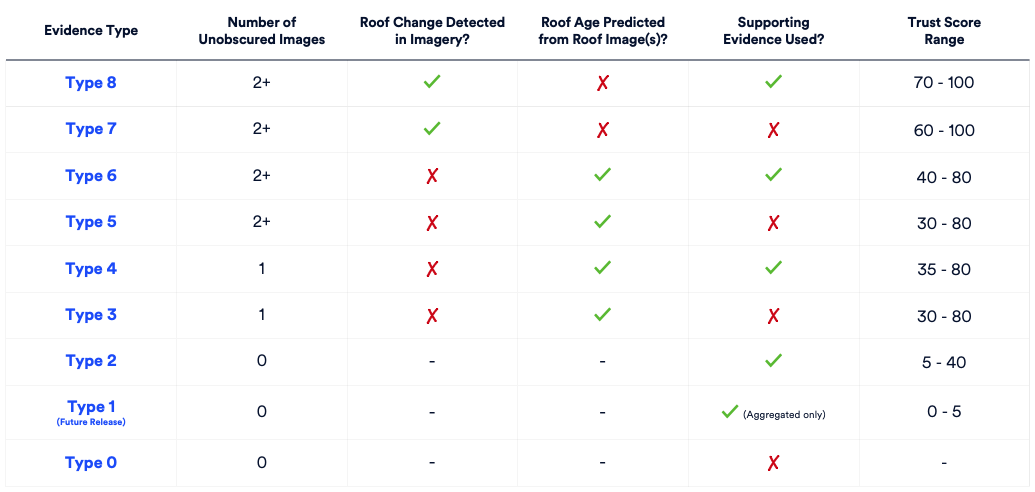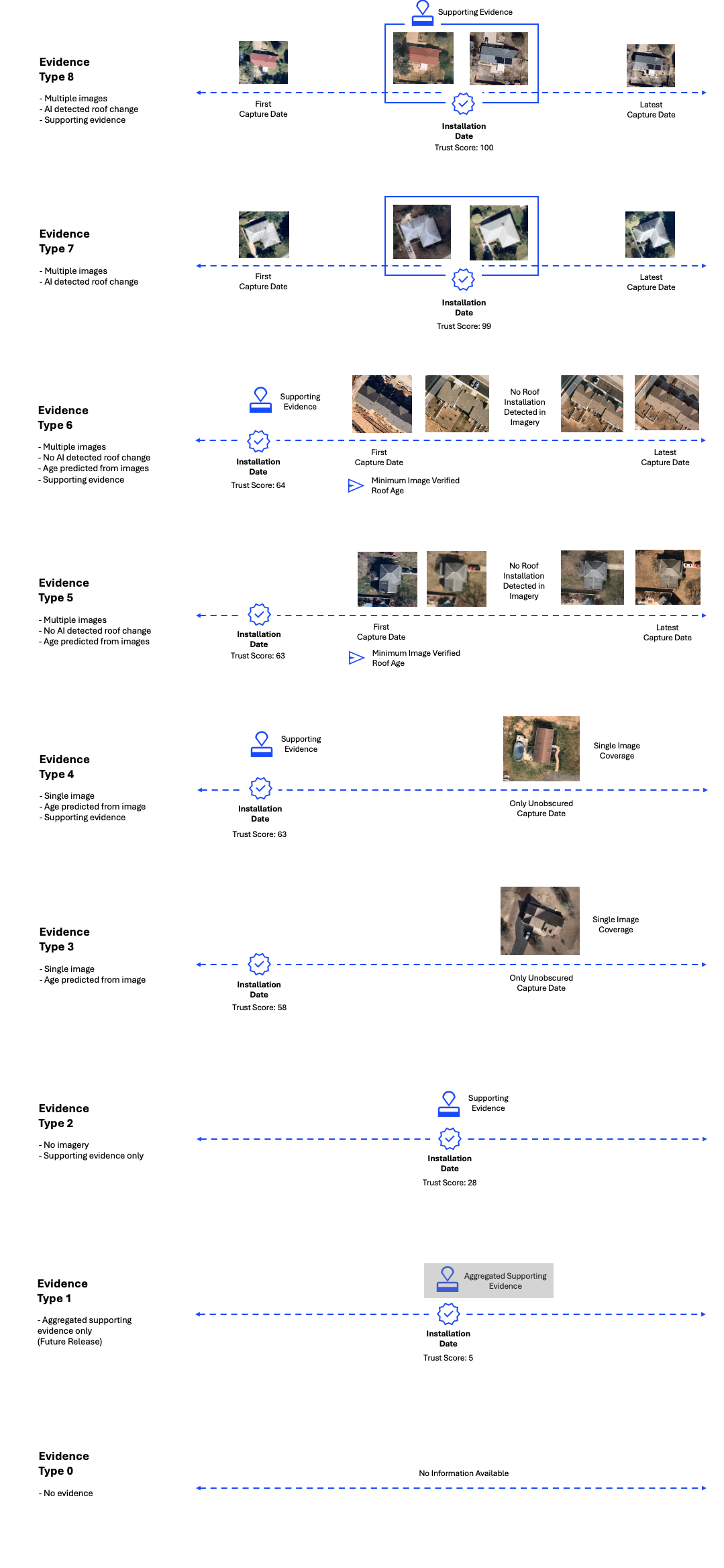Evidence Type
An Evidence Type represents the level of information used in roof age calculation.
Evidence Types range from Type 0 to Type 8 representing increasing levels information that has been used in the calculation. The Evidence Type summarizes the following data points:
- the amount of unobscured imagery available,
- whether a roof change was detected in the imagery, and
- whether there is non-imagery based supporting evidence for the predicted installation date.
A detailed definition of each Evidence Type is provided below as well as a table summary.
Evidence Type | Description |
|---|
Type 8 | There are multiple unobscured images of the roof. The AI model detects a roof change between two captures, and the roof installation date is set as the mid-point between these dates. Additionally, there are relevant building permits and/or assessor year-built data that supports the predicted installation date. |
Type 7 | There are multiple unobscured images of the roof. The AI model detects a roof change between two captures, and the roof installation date is set as the mid-point between these dates. There is no supporting evidence that corroborates the predicted installation date. |
Type 6 | There are multiple unobscured images available for the roof and the AI model does not detect a roof change between captures. A separate machine learning model predicts the age of the roof by using the available images as well as other sources such as climate data. Additionally, there are relevant building permits and/or assessor year-built data that supports the predicted installation date. |
Type 5 | There are multiple unobscured images available for the roof and the AI model does not detect a roof change between captures. A separate machine learning model predicts the age of the roof by using the available images as well as other sources such as climate data. There is no supporting evidence that corroborates the predicted installation date. |
Type 4 | There is a single unobscured image available for the roof so it is not possible to detect a new roof installation. A machine learning model predicts the age of the roof by using the available image as well as other sources such as climate data. Additionally, there are relevant building permits and/or assessor year-built data that supports the predicted installation date. |
Type 3 | There is a single unobscured image available for the roof so it is not possible to detect a new roof installation. A machine learning model predicts the age of the roof by using the available image as well as other sources such as climate data. There is no supporting evidence that corroborates the predicted installation date. |
Type 2 | There are no unobscured images available for the roof or parcel. However, there are relevant building permits and/or assessor year-built data that provide an indication of the roof installation date. |
Type 1: (Future Release) | There are no unobscured images available for the roof or parcel and there are no relevant building permits and/or assessor year-built data for that parcel. However, aggregated supporting evidence from the area can provide an indication of the likely age of roofs in that area. |
Type 0 | There are no unobscured images available for the roof or parcel and there are no relevant building permits and/or assessor year-built data for that parcel. No roof installation date is provided |
Summary Table

It is important to note that Evidence Types are representative of the information used in the calculation of roof age not the information available. For example, there may be additional imagery of the location that is not used due to being heavily occluded or there may be adjunct information available that is outdated and not used in the calculation and is therefore not considered for the calculation of Evidence Type.
Having supplementary evidence that isn’t imagery-based yet supports the imagery predictions strengthens confidence in the results and is reflected in both the Evidence Type and the Trust Score.
Trust Score
Each Evidence Type is associated with a Trust Score range which are listed in the summary table above. This represents the range of possible values that a roof age prediction with that Evidence Type can have. A higher amount of evidence used will result in a higher Trust Score. The Trust Score also considers the raw model prediction confidence as well as other factors such as the recency and type of evidence used.
Using the Trust Score and Evidence Type
The Trust Score reflects the reliability of the predicted roof age, enabling ranking from most to least dependable. Combined with the Evidence Type, it provides flexibility for integrating Roof Age outputs smoothly into existing workflows and internal processes.
Depending on the use case, you may choose to consider only image verified installation date by using only Evidence Type 7 and 8. Another suggested method is to filter by values of Trust Score depending on the desired tolerance of the reliability of predictions.
Evidence Types 3, 4, 5 and 6 are all based on predicting the age of the roof from imagery where no roof change can be seen and have largely overlapping ranges of Trust Score. If filtering of these predictions is required, it is suggested to use Trust Score rather than Evidence Type.
For example, a prediction that is Evidence Type 4 with Trust Score 68 is considered more reliable than a prediction that is Evidence Type 5 with Trust Score 52. This may be due to having one very clear image of the roof with Evidence Type 4 while having 7 images that are slightly occluded by trees or shadows in the case of the roof with Evidence Type 5.
Examples
The illustration below shows the available captures, supporting evidence and roof installation dates for example roof timelines for each of the Evidence Types. This shows how each of the roof ages is derived in each of the scenarios including the resulting Trust Score for these examples.
